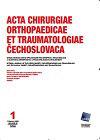[Posterior Tibial Slope as a Morphological Risk Factor for Anterior Cruciate Ligament Reconstruction: a Retrospective Cohort Study].
IF 0.4
4区 医学
Q4 ORTHOPEDICS
Acta chirurgiae orthopaedicae et traumatologiae Cechoslovaca
Pub Date : 2023-02-15
DOI:10.55095/achot2023/007
引用次数: 0
Abstract
PURPOSE OF THE STUDY Increased tibial slope facilitates anterior translation of tibia relative to the femur, thereby increasing the load on both the native and replaced anterior cruciate ligament. This study aims to retrospectively review the posterior tibial slope in a cohort of our patients after the ACL reconstruction and revision ACL reconstruction. Based on the results obtained by measurements, we aimed to confirm or disprove the claim that the increased posterior tibial slope is one of the risk factors of the ACL reconstruction failure. Another aim of the study was to assess whether there are any correlations between the posterior tibial slope and basic somatic parameters (height, weight, BMI) or the patient s age. MATERIAL AND METHODS The posterior tibial slope was measured retrospectively on lateral X-rays of 375 patients. There were 83 revision reconstructions and 292 primary reconstructions performed. The patient s age at the time of injury, height and weight were recorded and the BMI was calculated. The findings were then statistically analysed. RESULTS The mean posterior tibial slope in 292 primary reconstructions was 8.6 degrees, whereas the mean posterior tibial slope in 83 revision reconstructions was 12.3 degrees. The difference between the studied groups was statistically (p<0.0001) and substantively significant (d=1.35). In the breakdown into men and women, the mean tibial slope was 8.6 degrees in the group of men with primary reconstruction and 12.4 degrees in the group of men with revision reconstruction (p < 0.0001, d = 1.38). A similar result was achieved in women where in the group with primary reconstruction the mean tibial slope was 8.4 degrees, while in the group with revision reconstruction it was 12.3 degrees (p < 0.0001, d = 1.41). Furthermore, a higher age in men at the time of revision surgery (p = 0.009; d = 0.46) and a lower BMI in women at the time of revision surgery (p = 0.0342; d = 0.12) were observed. Conversely, neither height nor weight were different, both when comparing the whole groups and the groups in a breakdown by sex. DISCUSSION As regards the main aim, our results are in line with the results reported by majority of other authors, and they are substantively significant. The posterior tibial slope is a significant risk factor in anterior cruciate ligament replacements, with tibial slope above 12 degrees increasing the risk of ligament failure, namely both in men and women. On the other hand, this is obviously not the sole cause of the ACL reconstruction failure since there are also other risk parameters. It is not yet clear whether it makes sense to indicate correction osteotomy before the ACL replacement in all patients with an increased posterior tibial slope. CONCLUSIONS Our study confirmed a greater posterior tibial slope in the revision reconstruction group compared to the primary reconstruction group. Thus, we confirmed that greater posterior tibial slope may be a factor leading to the ACL reconstruction failure. Since the posterior tibial slope is easily measured on the baseline X-rays, we recommend to perform this measurement routinely before each ACL reconstruction. In the case of a high posterior tibial slope, slope correction should be considered to prevent potential ACL reconstruction failure. Key words: anterior cruciate ligament reconstruction, ACL graft failure, morphological risk factors, posterior tibial slope.[胫骨后坡是前交叉韧带重建的形态学危险因素:一项回顾性队列研究]。
研究目的增加胫骨斜率有助于胫骨相对于股骨向前平移,从而增加天然和置换前交叉韧带的负荷。本研究旨在回顾性回顾我们的一组患者在ACL重建和翻修ACL重建后的胫骨后斜坡。根据测量结果,我们旨在证实或反驳胫骨后倾增加是ACL重建失败的风险因素之一的说法。该研究的另一个目的是评估胫骨后坡与基本身体参数(身高、体重、BMI)或患者年龄之间是否存在相关性。材料与方法对375例患者的胫骨后倾进行了回顾性侧位X线测量。共进行了83次翻修重建和292次初次重建。记录患者受伤时的年龄、身高和体重,并计算BMI。然后对调查结果进行统计分析。结果292例初次重建的平均胫骨后倾为8.6度,83例翻修重建的平均胫后倾为12.3度。研究组之间的差异具有统计学意义(p<0.0001)和实质性意义(d=1.35),初次重建组和翻修重建组的平均胫骨斜率分别为8.6度和12.4度(p<0.0001,d=1.38),而翻修重建组为12.3度(p<0.0001,d=1.41)。此外,男性翻修手术时的年龄较高(p=0.009;d=0.46),女性翻修手术时BMI较低(p=0.0342;d=0.12)。相反,无论是在比较整个组还是按性别细分的组时,身高还是体重都没有差异。讨论关于主要目标,我们的结果与大多数其他作者报告的结果一致,具有实质意义。胫骨后倾是前交叉韧带置换术的一个重要风险因素,胫骨后倾超过12度会增加韧带失效的风险,无论男女。另一方面,这显然不是ACL重建失败的唯一原因,因为还有其他风险参数。目前尚不清楚在所有胫骨后倾增加的患者中,在ACL置换术前进行矫正截骨是否有意义。结论:我们的研究证实,与初次重建组相比,翻修重建组的胫骨后倾更大。因此,我们证实较大的胫骨后倾可能是导致ACL重建失败的一个因素。由于胫骨后倾在基线X光片上很容易测量,我们建议在每次ACL重建前进行常规测量。在胫骨后斜坡较高的情况下,应考虑斜坡矫正,以防止潜在的ACL重建失败。关键词:前交叉韧带重建,前交叉韧带移植物失败,形态学危险因素,胫骨后斜坡。
本文章由计算机程序翻译,如有差异,请以英文原文为准。
求助全文
约1分钟内获得全文
求助全文
来源期刊
CiteScore
0.70
自引率
25.00%
发文量
53
期刊介绍:
Editorial Board accepts for publication articles, reports from congresses, fellowships, book reviews, reports concerning activities of orthopaedic and other relating specialised societies, reports on anniversaries of outstanding personalities in orthopaedics and announcements of congresses and symposia being prepared. Articles include original papers, case reports and current concepts reviews and recently also instructional lectures.

 求助内容:
求助内容: 应助结果提醒方式:
应助结果提醒方式:


